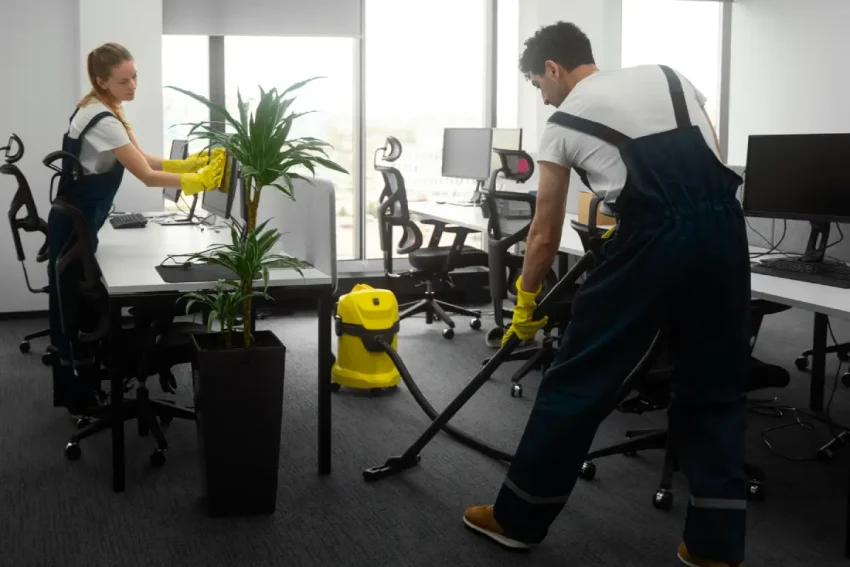Green Cleaning Methods for Modern Workspaces

Traditional cleaning products and procedures often introduce harsh chemicals into the workplace, impacting indoor air quality and worker health. These chemical-laden agents can linger in the air and on surfaces, causing irritation, allergies, and even long-term health problems for employees exposed daily to such compounds.
Persistent exposure can lead to chronic respiratory conditions or worsen symptoms for those with pre-existing allergies and asthma. By switching to green cleaning, businesses can significantly reduce their environmental footprint and demonstrate a genuine commitment to social responsibility, providing safer, healthier offices that appeal to eco-conscious clients, partners, and visitors.
In environments where people spend most of their day, minimizing exposure to toxic substances is key to enhancing comfort, satisfaction, and productivity. As organizations strive to create workplaces that attract top talent, adopting eco-friendly cleaning practices signals an investment in staff well-being and a dedication to sustainability that future-proofs the business.
Modern offices demand an approach to cleanliness that ensures a hygienic environment, safeguards employee well-being, and supports environmental sustainability. In today’s fast-paced corporate world, most organizations have come to recognize that the success of a workplace hinges not just on hard work, but on the health and happiness of those who occupy the space.
Green cleaning methods are becoming vital in today’s business world, where the emphasis on health and eco-friendliness is stronger. Unlike in the past, when cleanliness was mainly focused on visual appeal and removing visible dirt, today’s organizations understand the importance of maintaining indoor environments free of visible dirt and invisible toxins.
Companies committed to maintaining high standards are increasingly partnering with NYC commercial cleaning services specializing in sustainable solutions for modern workspaces, ensuring their offices reflect an ethos of responsibility toward employees and the planet. By implementing these methods, modern offices support the environment and position themselves as leaders in a rapidly evolving business climate.
Contents
Why Choose Green Cleaning?
Green cleaning means adopting environmentally responsible cleaning practices that reduce toxic exposure and limit ecosystem damage. It is not simply a trend; it’s a shift in mindset about how everyday business operations can impact the world around us. For leaders and facility managers, green cleaning is a proactive step toward a healthier indoor environment, which is crucial given how much time employees spend at work.
Conventional cleaning agents frequently release volatile organic compounds (VOCs) and hazardous pollutants into the atmosphere, which are linked to respiratory problems, skin irritation, and poor indoor air quality—issues that can significantly disrupt workplace wellness. These substances are often invisible but have long-term negative consequences, including sick building syndrome and higher rates of employee absenteeism.
By adopting green cleaning, businesses nurture a safer, more welcoming work atmosphere that benefits everyone exposed to the environment daily. The U.S. Environmental Protection Agency stresses that indoor air can be up to five times more polluted than outdoor air, highlighting the importance of sustainable cleaning approaches.
Adopting green cleaning is therefore one of the most effective actions companies can take to protect their workforce’s health and productivity. This change can also give companies a competitive edge as they respond to increased stakeholder demand for sustainability.
Eco-Friendly Cleaning Products
The foundation of any green cleaning program is the savvy selection and use of environmentally safe cleaning products. These products are designed to be biodegradable, contain fewer harmful chemicals, and are often certified by organizations such as Green Seal or the EPA Safer Choice program, assuring users that the products have met strict environmental standards.
Instead of relying on harsh solvents or strong artificial fragrances, green products utilize natural, plant-based ingredients and non-toxic disinfectants that are gentle on people and the environment. This switch reduces the risk of allergic reactions among employees and visitors while minimizing residues left behind on frequently touched surfaces. Not only does this improve safety and comfort, but it also provides peace of mind, knowing that offices are maintained responsibly.
When evaluating which cleaning agents to introduce to your office, it is crucial to look for third-party labeling and certifications that verify their environmental claims, since “green” marketing terms alone are not a guarantee of sustainability. Purchasing products in concentrated forms and refillable containers also reduces packaging waste, further reducing a workspace’s environmental impact. Making thoughtful purchasing decisions ensures your green cleaning efforts are thorough and authentic.
Sustainable Cleaning Practices
Changing what we clean with is only part of a responsible cleaning approach, but how a workspace is cleaned matters just as much. Sustainable cleaning practices begin with using highly effective tools like reusable microfiber cloths and mop heads, which can capture and trap more dirt, dust, and bacteria than single-use alternatives.
Microfiber helps maintain a healthier environment and reduces the frequency with which cleaning agents are needed, saving money and resources. By implementing color-coded cleaning tools—distinct sets for kitchens, bathrooms, and communal spaces—workplaces can effectively limit cross-contamination and boost hygiene standards.
Consistently following regularly scheduled cleaning routines helps minimize the need for deep cleaning cycles, preventing dirt and germs from accumulating to problematic levels. Sustainable practices also mean responsibly disposing of any waste created, properly recycling used bottles or packaging, and minimizing reliance on single-use products wherever possible.
Simple adjustments like cleaning schedules and optimizing routes can result in measurable environmental benefits. Every step counts in keeping the workplace clean and green, especially as sustainability is integral to corporate culture.
Energy-Efficient Cleaning Equipment
Modern cleaning machines offer energy-saving features that benefit the environment and an organization’s bottom line. Equipment such as HEPA-filtered vacuums and floor scrubbers with the ENERGY STAR certification deliver optimal results while using less energy than their conventional counterparts. These machines are designed to use power more efficiently, often featuring settings that adjust water and detergent consumption based on the cleaning job.
Smart robotic cleaning devices, which can be programmed to operate during off-peak hours, reduce workplace disruptions and harness building energy more efficiently, leading to lower energy costs. Companies that invest in high-efficiency cleaning devices reinforce their commitment to sustainability and can lower operating expenses in the long run.
Proper machinery maintenance is also essential for maximizing energy efficiency and extending the lifespan of valuable cleaning assets. Regular checks and timely repairs ensure that equipment does not draw more power than necessary, and keep operations running smoothly without unwanted downtime.
Water Conservation Techniques
Traditional cleaning methods can be highly water-intensive, consuming more resources than necessary. The importance of conserving water in modern cleaning practices cannot be overstated, given growing concerns over global water scarcity. Green cleaning professionals employ carefully crafted techniques such as damp mopping, targeted spot cleaning, and advanced cleaning machines that recover and recycle their water.
These innovative approaches can dramatically reduce water usage, helping offices simultaneously cut their utility bills and environmental impact. Touchless cleaning systems that rely on high-pressure, low-flow water jets can efficiently clean large areas with under half the water typically required.
By reviewing cleaning processes and switching to smarter techniques, organizations contribute to preserving this precious natural resource and setting a strong example of local environmental stewardship. Implementing water-saving strategies is environmentally responsible and can be a key talking point when demonstrating your company’s sustainability efforts to clients and visitors.
Employee Training and Engagement
Achieving the full benefits of green cleaning depends on employee participation and awareness throughout all levels of the organization. Comprehensive training programs should educate staff on selecting, handling, and safely storing eco-friendly products; clarify the best cleaning protocols for various surfaces; and teach proper procedures for managing and sorting waste. These training initiatives empower employees to take personal responsibility and actively participate in sustainability efforts.
When employees are involved and receive feedback about the success of sustainability initiatives, they’re more likely to feel included and motivated to participate. Creating clear signage about recycling, hand-washing, and responsible use of cleaning products further supports engagement and long-term adoption.
Inclusion in sustainability initiatives can empower staff and create a culture of shared responsibility, strengthening overall company morale and fostering a lasting impact. Staff who understand the value of these efforts are more likely to maintain high cleaning and sustainability standards. Integrating green cleaning values into onboarding and regular meetings ensures that sustainability remains a core part of your organizational identity.
Benefits of Green Cleaning
Embracing green cleaning offers many benefits beyond simply keeping the office neat. Improved indoor air quality—free from harsh chemicals and excessive dust—results in fewer employee health complaints, lowering absenteeism, and boosting overall productivity. Reducing the use of toxic substances protects cleaning staff and shields the wider workforce from potentially hazardous exposure.
Over time, these practices provide measurable improvements in both employee health and company culture. Furthermore, potential clients and business partners increasingly value environmentally conscious practices, enhancing a company’s reputation and competitive edge.
Companies prioritizing sustainability are often recognized in their communities and can take advantage of ecologically focused certification programs, such as LEED and WELL Building Standard, which reward responsible cleaning practices. Ultimately, choosing green cleaning positions businesses as leaders and innovators in their industries, reflecting forward-thinking values that matter to today’s workforce and customers.
Implementing Green Cleaning in Your Workspace
Transitioning to green cleaning involves thoroughly assessing current cleaning procedures and materials, identifying products and practices that don’t align with sustainability goals, shifting purchasing priorities to eco-friendly agents, investing in energy and water-efficient tools, and providing ongoing staff training and communication.
Leaders should conduct periodic reviews of cleaning protocols and take feedback from staff to ensure progress. Establishing relationships with service providers specializing in green cleaning can give organizations a competitive edge and provide valuable resources.
Leveraging recognition and certification programs can externally validate environmental efforts and build credibility. Adopting green cleaning methods is more than just a trend; it is a commitment to environmental stewardship and long-term wellness. By making mindful choices and developing strategic partnerships, businesses can contribute to a healthier, greener future.



